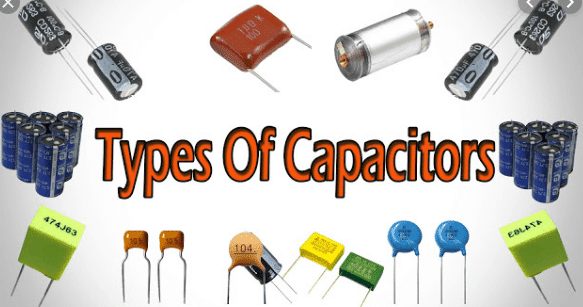 “A capacitor is a device that can store charge.”Apart from resistors and inductors, it is the other basic component commonly used in electronic circuits. It is a device that has the ability to store charge which neither a resistor nor an inductor can do, it opposes any change of voltage in the circuit in which it is connected, it blocks the passage of direct current through it.
“A capacitor is a device that can store charge.”Apart from resistors and inductors, it is the other basic component commonly used in electronic circuits. It is a device that has the ability to store charge which neither a resistor nor an inductor can do, it opposes any change of voltage in the circuit in which it is connected, it blocks the passage of direct current through it.
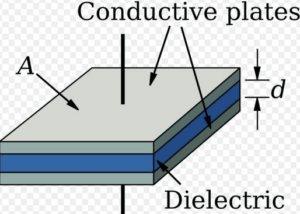
They are manufactured in various sizes, shapes, types, and values. Essentially, a capacitor consists of two conducting plates separated by an insulating medium called a dielectric.
dielectric could be air, mica, ceramic, paper, polyester, polystyrene or polycarbonate plastics, etc..
How do capacitor stores charge?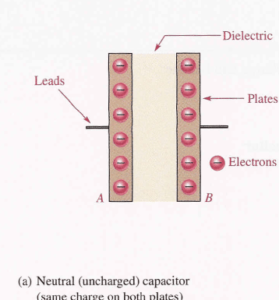
In the neutral state, both plates of a capacitor have an equal number of free electrons.
When the capacitor is connected to a voltage source through a resistor as shown in the figure below:
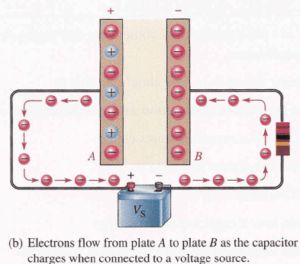
electrons are moved from plate A, and an equal number are deposited on plate B. As plate A losses electrons and plate B gain electrons, plate A becomes positive with respect to plate B. During this charging process, electrons flow only through the connecting leads and the source.No electrons flow through the dielectric of the capacitors because it is an insulator. The movement of electrons ceases when the voltage across the capacitor equals the source voltage as shown in the figure below:
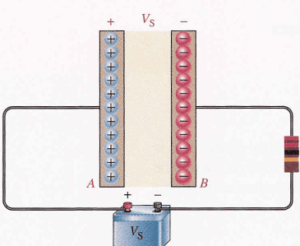
If the capacitor is disconnected from the source it retains stored charge for a long period of time (the length of time depends on the type of capacitor) and still has a voltage across it as shown in the figure:
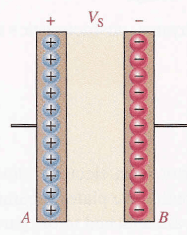
A charged capacitor can act as a temporary battery and the following points should be noted
- No current can flow through the capacitor because of the presence of dielectric in the circuit which offers infinite resistance. The electric charge is momentarily displaced from one plate to another through the external circuit only.
- As a potential difference between the plates is increased, the dielectric medium comes under increasing stress If this potential difference is increased, the strength in the dielectric increases till it can no longer bear it.
At this stage, electrical breakdown occurs accompanied by a spark between the two capacitor plates. The maximum voltage per meter thickness that a medium can withstand without a rupture or breakdown is called its dielectric strength.
How a capacitor Discharges?
If two leads of charged capacitors are connected together, the potential difference between the two plates is equalized and it becomes discharged.
since there exists a potential difference between the two plates, an electric field is set up between them whose strength is given by:
E=V/d
where V is volt and d is the meter.
How capacitors store energy?
It stores energy in the form of an electric field that is established by the opposite charges on the two plates. The electric field is represented by the lines of force between the positive and negative charges and concentrated within the dielectric, As shown in fig…
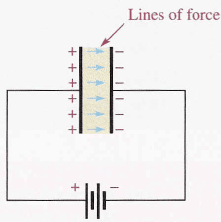
Coulomb’s law states
A force exists between two-point source charges that are directly proportional to the product of the two charges and inversely proportional to the square of the distance between the charges. this relationship is expressed as:
![]()
where F is the force in newton, q1 and q2 are the charges in coulombs,d is the distance between the charges in meters, and k is a proportional constant equal to 9×10 -9 Nm²/C².

Figure above illustrates a line of force between a positive and a negative charge.

The above figure shows that many opposite charges on the plates of a capacitor create many lines of force, which form an electric field that stores energy within the dielectric.
The greater the forces between the charges on the plates of a capacitor, the more energy is stored. Therefore, the amount of energy is directly proportional to the capacitance because the more charge stored, the greater the force.
Also from equation Q=CV, the amount of charge stored is directly related to the voltage as well as to the capacitance. Therefore, the amount of energy stored is also dependent on the square of the voltage across the plates of the capacitor. The formula for the energy stored by a capacitor is

When capacitance (C) is in farads and voltage (V) is in volts, energy (w) is in joules.
Voltage Rating:
Every capacitor has a limit on the amount of voltage that it can withstand across its plates. The voltage rating specifies the maximum DC voltage that can be applied without the risk of damage to the device. If this maximum voltage, commonly called the breakdown voltage or working voltage, is exceeded, permanent damage to the capacitor can result.
Both the capacitance and the voltage rating must be taken into consideration before a capacitor is used in a circuit application. The choice of capacitance value is based on particular circuit requirements. The voltage rating should always be above the maximum voltage expected in a particular application.
Dielectric Strength:
The breakdown voltage of a capacitor is determined by the dielectric strength of the electric material used. The dielectric strength is expressed in V/mil (1 mil=0.01 in). Given below are some typical values for several materials. Exact values vary depending on the specific composition of the material.
Material Dielectric strength (v/mil)
- Air 80
- Oil 375
- Ceramic 1000
- Paper 1200
- Teflon 1500
- Mica 1500
- Glass 2000
The dielectric strength can best be explained by an example. Assume that a certain capacitor has a plate separation of 1 mil and that the dielectric material is ceramic. This particular capacitor can withstand a maximum voltage of 1000 V because its dielectric strength is 1000 V/mil. If the maximum voltage is exceeded, the dielectric may break down and conduct current, causing permanent damage to the capacitor.
Temperature coefficient:
The temperature coefficient indicates the amount and direction of a change in capacitance value with temperature. A positive temperature coefficient means that the capacitance increases with an increase in temperature or decreases with a decrease in temperature. A negative coefficient means that the capacitance decreases with an increase in temperature or increases with a decrease in temperature. Temperature coefficients are typically specified in parts per million per Celsius degree(ppm/°C).
Leakage:
No insulating material is perfect. The dielectric of any capacitor will conductor will conduct some very small amount of current. Thus, the charge on a capacitor will eventually leak off. Some types of capacitors, such as large electrolyte types, have higher leakages than others.
Types of capacitors
Fixed capacitors
- Mica capacitors
- ceramic capacitors
- plastic film capacitors
- electrolytic capacitors
- paper capacitors
Mica capacitor
Two types of mica capacitors are stacked foil and silver mica. The basic construction of the stacked foil type is shown as:
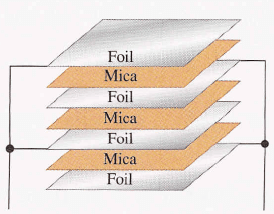
It consists of alternate layers of metal foil and thin sheets of mica. The metal foil forms the plate, with alternate foil sheets connected together to increase the plate area. More layers are used to increase the plate area, thus increasing the capacitance. The mica/foil stack is encapsulated in an insulating material such as Bakelite as shown in the figure.
A silver mica capacitor is formed in a similar way by stacking mica sheets with silver electrode material screened on them. Mica capacitors are available with capacitance values ranging from 1pF to 0.1 μF and voltage ratings from 100 v to 2500 v dc. Common temperature coefficients range from -20 ppm/C° to +100 ppm/C°. Mica has a typical dielectric constant of 5.
Ceramic capacitors
Ceramic dielectrics provide very high dielectric constants (1200 is typical). As a result, comparatively high capacitance values can be achieved in a small physical size. Ceramic capacitors are commonly available in ceramic disk form.

Ceramic capacitors typically are available in capacitance values ranging from 1 pF to 2.2 μF with voltage ratings up to 6 kV. A typical temperature coefficient for ceramic capacitors is 200,000 ppm/C°.
Plastic film capacitors
There are several types of plastic film capacitors. Polycarbonate, propylene, polyester, polystyrene, and Mylar are some of the more common dielectric materials used. Some of these types have capacitance values up to 100 μF.
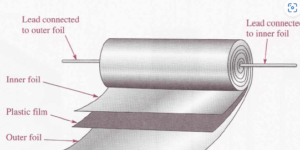
The figure shows a common basic construction used in many plastic film capacitors. A thin strip of plastic film dielectric is sandwiched between two thin metal strips that act as plates. One lead is connected to the inner plate and one to the other plate as indicated. The strips are then rolled in a spiral configuration and encapsulated in a molded case . Thus, a large plate area can be packaged in a relatively small physical size, thereby achieving large capacitance values. Another method uses metal deposited directly on the film dielectric to form the plates.
Electrolytic capacitors
Electrolytic capacitors are polarized so that one plate is positive and the other is negative. These capacitors are used for capacitance values from 1μF up to over 200,000 μF, but they have relatively low breakdown voltages (350 V is a typical maximum) and high amounts of leakage. In this text, capacitors with values of 1 μF or greater are considered to be polarized.
Electrolytic capacitors offer much higher values than mica or ceramic capacitors, but their voltage ratings are typically lower. Aluminum electrolytic s are probably the most commonly used type.
Variable capacitors
Variable capacitors are used in a circuit when there is a need to adjust the capacitance value either manually or automatically, for example, in radio or TV tuners. The schematic symbol for a variable capacitor is shown in the figure:

Adjustable capacitors that normally have slotted screw-type adjustment and are used for very fine adjustment in a circuit are called trimmers. Ceramic or mica is a common dielectric in these types of capacitors, and the capacitance usually is changed by adjusting the plate separation. The below figure shows some typical variable capacitor devices.
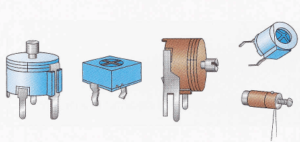
The varactor is a semiconductor device that exhibits a capacitance characteristic that is varied by changing the voltage across its terminals.
Applications of capacitors in real life
- They used in timer
- Timebase circuit in CRO to generate a sawtooth wave
- Filter circuits
- Oscillators
- Tuner circuit in the radio
- As a timer in frequency setting with oscillator
- Integrating and differentiating circuits
- Voltage multiplier
- Peak detector
- Demodulator
- Clamping circuits
- In AC motors to enhance torque
- Convert active power into passive power
types of capacitor and their applications (video)
See also: